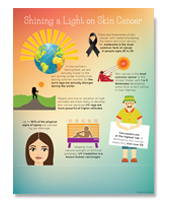Itsy-Bitsy, Teeny-Weeny
Think we’re talking about bikinis? Nope, we’re talking about your chances of avoiding skin cancer if you insist on spending time in the sun without protecting yourself.
Skin Cancer Epidemic
Skin cancer is the most common cancer in the United States. In the United States alone, it kills one person every 57 minutes. And one in five Americans will develop some form of skin cancer in their lifetime. Each year, more new cases of skin cancer are diagnosed than cancers of the breast, prostate, lung and colon combined. And more people develop skin cancer from tanning than develop lung cancer from smoking.
Killer Cancer
The rarest and most dangerous form of skin cancer is melanoma. It can be lethal if it isn’t caught early. Melanoma has a high probability of spreading to other parts of the body, eventually leading to death. Ironically, while melanoma is the rarest form of skin cancer, it is the most common form of cancer in people ages 25 to 29.
It Gets Ugly
Melanomas aren't the only dangerous skin cancers. Aggressive non-melanoma skin cancers (ANMSCs) can be extremely destructive if not detected and treated early. They’re usually found on the head, face and neck. They tend to grow large and deep, and they spread quickly. They also recur more often and lead to death more often than other types of basal cell and squamous cell carcinomas. And even though removing them runs the risk of ugly scarring, they should be treated aggressively.
Protect Yourself
Ultraviolet radiation is a known human carcinogen — whether from natural sunlight or artificial sunlamps. So avoid tanning beds — period. Remember, skin cancer is deadly. And if you’re going to be outdoors for any length of time, follow these rules.
- Use a sunscreen with both UVA and UVB protection and with an SPF of 15 or higher**
- Stay in the shade during midday
- Buy sunglasses that block UVA and UVB
- Examine your skin monthly
The Facts
Here are a few other facts to be aware of. Most cases of skin cancer are caused by exposure to ultraviolet light from the sun and tanning beds. In the northern hemisphere, we are actually closer to the sun during winter months than during summer months. That means the sun’s rays are actually stronger during the winter. Use sunscreen. If you’re near water, even if you’re in the shade, you will be subject to reflected sunlight. Wear sunscreen. If you live or vacation at high altitudes you’re more likely to develop skin cancer because UV rays are more powerful at higher altitudes. Put on the sunscreen! Here’s one last bit of motivation — up to 90 percent of the physical signs of aging are caused by … sun damage.
**According to Florida dermatologist James M. Spencer, on WebMD, an SPF 15 product blocks about 94 percent of UVB rays; an SPF 30 product blocks 97 percent of UVB rays; and, an SPF 45 product blocks about 98 percent of UVB rays. (seen 3-24-2016: http://www.webmd.com/beauty/sun/high-spf-sunscreens-are-they-better)

